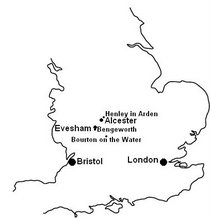This paragraph is from Baptists and Britons: Particular Baptist Ministers in England and British identity in the 1790s by John Robert Parnell, B.A., M.A. a dissertation Prepared for a PhD with the University of North Texas, December 2005 available here
Though they continued to represent only a small percentage of the nation’s population, Baptists grew in terms of the number of members. In 1750, approximately 10,000 Particular Baptists resided in England. (Currie, Gilbert, and Horsley, Churches and Churchgoers, 151.) Members of Particular Baptist churches numbered 17,000 in 1790, but the number of members had risen to 24,000 by 1800. (Gilbert, Religion and Society, 37) For comparison, England’s population in 1791 was 7.74 million and by 1801 it was 8.6 million.(William B. Willcox and Walter L. Arnstein, The Age of Aristocracy, 1688-1830 8th ed. (Boston: Houghton Mifflin, 2001), 327.) By Gilbert’s assessment, Baptists made up only 0.5 percent of the population in England aged fifteen and over in 1800. (Gilbert, Religion and Society, 39.) In another calculation, Watts concludes that the Baptist portion of the population, including both Particular and General Baptists, rose from 1.09 percent in England from 1715 to 1718 to 2.95 percent by 1851.(Watts, Dissenters, vol. II, 28-29.) Such growth was especially evident in the 1790s. From 1791 to 1800, the number of registered places for Baptist worship increased, with the registrations of temporary locations rising from eighty-nine to 170 and those of permanent locations from thirty to seventy-four. (Gilbert, Religion and Society, 34.) Although the numbers of Baptist congregations had declined from 1716 to 1773, they rose from the 1770s. (Gilbert, Religion and Society, 35.) According to John Rippon’s accounts in the Baptist Annual Register, a total of 379 Particular Baptist churches existed from 1790 to 1801.(Geoffrey E. Nuttall, “The Baptist Churches and their Ministers in the 1790s: Rippon’s Baptist Annual Register,” Baptist Quarterly 30 (1984): 384.) By 1800 Baptists lagged behind only Methodists and Independents for nonconformist congregations in England. (Watts, Dissenters, vol. II, 23). Rippon reported that during the 1790s every English county except Westmorland had at least one Baptist church. (Nuttall, “Baptist Churches in the 1790s,” 384). People began to see Baptist churches as an attractive alternative to the Church of England. A church only grows if its members recognize its usefulness or relevance in achieving goals. (Currie, Gilbert, and Horsley, Churches and Churchgoers, 7.)











No comments:
Post a Comment